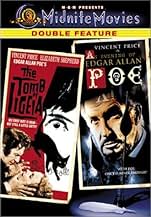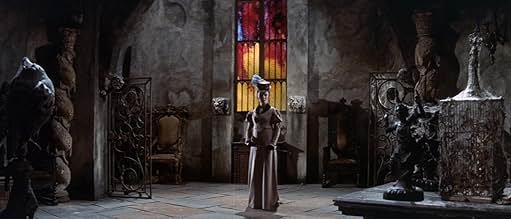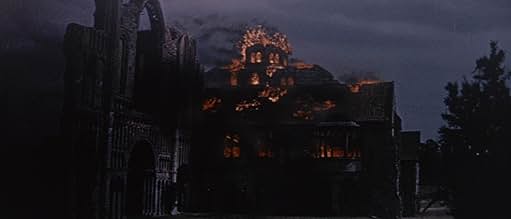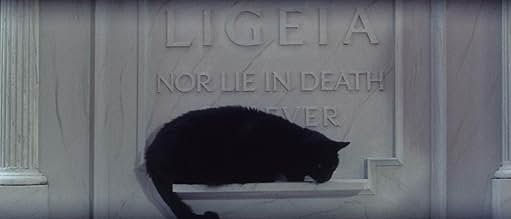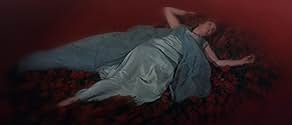IMDb रेटिंग
6.4/10
7.3 हज़ार
आपकी रेटिंग
मृत पत्नी के प्रति एक आदमी का जुनून, उसके और उसकी नई नवेली दुल्हन के रिश्ते में कील की तरह चुभता है.मृत पत्नी के प्रति एक आदमी का जुनून, उसके और उसकी नई नवेली दुल्हन के रिश्ते में कील की तरह चुभता है.मृत पत्नी के प्रति एक आदमी का जुनून, उसके और उसकी नई नवेली दुल्हन के रिश्ते में कील की तरह चुभता है.
- निर्देशक
- लेखक
- स्टार
Maxwell Craig
- Wedding Guest
- (बिना क्रेडिट के)
Anthony Lang
- Wedding Guest
- (बिना क्रेडिट के)
Del Watson
- Footman
- (बिना क्रेडिट के)
Fred Wood
- Wedding Guest
- (बिना क्रेडिट के)
फ़ीचर्ड समीक्षाएं
Amidst a crumbling castle in 19th century England, a widowed aristocrat (Vincent Price) mourns his wife, but quickly develops a new romantic relationship after meeting the forceful Rowena (Elizabeth Shepherd). Yet the soul of Ligeia seems to be haunting the estate and the apparently mesmerized Baron is hiding something.
Released in late 1964, "The Tomb of Ligeia" is Gothic horror based on the Edgar Allan Poe story from 1838 (which was revised in 1845 with the addition of his 1843 poem "The Conqueror Worm," written by the character Ligeia). This was the last of Roger Corman's eight Poe films from 1960-1964, which all made money but this one made the least, possibly because the quasi-series had run its course and the story was overly complicated. Nevertheless, Corman considered it one of the best of the lot.
Since the original tale was so short, scriptwriter Robert Towne incorporated elements from other Poe stories, such as the black cat, mesmerism and a hint of necrophilia. The talky story isn't as compelling as Corman's "The Terror" (1963) or even "The Masque of the Red Death" (1964). It's rather boring for the first hour, but there's an effectively creepy payoff in the last act, which ties everything together. Like those previous two films, the sumptuous Gothic ambiance is worth the price of admission and the inclusion of Stonehenge is a highlight. You just have to acclimate to the dated drama-focused goings-on.
The movie runs 1 hour, 22 minutes and was shot at Shepperton Studios, just west of London, and Castle Acre Priory north of Swaffham, as well as other spots in England, such as Stonehenge, Polesden Lacey and Polzeath, Cornwall, at the southwest tip of Britain (the beach scene).
GRADE: B-/C+
Released in late 1964, "The Tomb of Ligeia" is Gothic horror based on the Edgar Allan Poe story from 1838 (which was revised in 1845 with the addition of his 1843 poem "The Conqueror Worm," written by the character Ligeia). This was the last of Roger Corman's eight Poe films from 1960-1964, which all made money but this one made the least, possibly because the quasi-series had run its course and the story was overly complicated. Nevertheless, Corman considered it one of the best of the lot.
Since the original tale was so short, scriptwriter Robert Towne incorporated elements from other Poe stories, such as the black cat, mesmerism and a hint of necrophilia. The talky story isn't as compelling as Corman's "The Terror" (1963) or even "The Masque of the Red Death" (1964). It's rather boring for the first hour, but there's an effectively creepy payoff in the last act, which ties everything together. Like those previous two films, the sumptuous Gothic ambiance is worth the price of admission and the inclusion of Stonehenge is a highlight. You just have to acclimate to the dated drama-focused goings-on.
The movie runs 1 hour, 22 minutes and was shot at Shepperton Studios, just west of London, and Castle Acre Priory north of Swaffham, as well as other spots in England, such as Stonehenge, Polesden Lacey and Polzeath, Cornwall, at the southwest tip of Britain (the beach scene).
GRADE: B-/C+
Of all the collaborations between director Roger Corman and sensuous, creepy actor Vincent Price, this is probably their best. There's the small cast of characters, mainly Ligeia, buried in a marble tomb in the grounds of a sinister old abbey, Rowena, a lady horserider looking for someone she can be 'drawn' to who is more interesting than her beau Christopher, and Verdon, Ligeia's bereaved husband, with his black shades and mood swings. There's also a cat. And this cat is really the true star of the film, watching, attacking, influencing.
The film benefits from its heavy use of locations, and makes it stand apart from the studio interiors of other adaptations. This is a decadent, decaying England with strange happenings and curses. It is a superb film, and lifts the Shepperton Poe adaptations to a new level.
The film benefits from its heavy use of locations, and makes it stand apart from the studio interiors of other adaptations. This is a decadent, decaying England with strange happenings and curses. It is a superb film, and lifts the Shepperton Poe adaptations to a new level.
The genius of Edgar Allan Poe lies in his ability to create atmosphere and to draw us in with the power of his magically evocative language. As not a great deal happens in his stories and his characters are thinly drawn, film adaptors feel obliged to invent, expand, elaborate and embellish and this, the last of Roger Corman's versions of Poe, is certainly no exception. The liberties taken and the additions made by Robert Towne are too numerous to mention and include mesmerism and a hint of necrophilia!
The major change is that the marriage between Verden Fell and his second wife, Lady Rowena, is based upon love and not mutual loathing. Their characters have been fleshed out in the forms of Vincent Price as Fell and the lovely Elizabeth Shepherd as Rowena. Unfortunately Mr. Price's persona and air of mystery are unable to compensate for the fact that he is simply too long in the tooth for the role whilst Rowena's freedom of spirit and sensuality make her overpowering attraction to him faintly ludicrous. It is of course highly unlikely that the film would have received financial backing had Mr. Price not been in it.
As one has come to expect from Mr. Corman this film has excellent production values and art direction and is aided by a strong supporting cast.
Poe died in comparative poverty but his works have supplied a framework by which film-makers have enriched themselves. Mr. Corman especially has helped keep Poe's name alive but one must never lose sight of the original stories which remain, of their type, unparalleled.
The major change is that the marriage between Verden Fell and his second wife, Lady Rowena, is based upon love and not mutual loathing. Their characters have been fleshed out in the forms of Vincent Price as Fell and the lovely Elizabeth Shepherd as Rowena. Unfortunately Mr. Price's persona and air of mystery are unable to compensate for the fact that he is simply too long in the tooth for the role whilst Rowena's freedom of spirit and sensuality make her overpowering attraction to him faintly ludicrous. It is of course highly unlikely that the film would have received financial backing had Mr. Price not been in it.
As one has come to expect from Mr. Corman this film has excellent production values and art direction and is aided by a strong supporting cast.
Poe died in comparative poverty but his works have supplied a framework by which film-makers have enriched themselves. Mr. Corman especially has helped keep Poe's name alive but one must never lose sight of the original stories which remain, of their type, unparalleled.
Very fine Poe adaptation. I had always reckoned Masque of the Red Death, from the same period to be far superior, but not so. Viewed again this is very well put together, especially the first half, which is really only setting the scene for the Poe tale to be told. Not quite as stylish as the aforementioned film, this is still, nevertheless, possessed of a very strong dream like quality and builds scarily as doors rattle, animals squawk and the inevitable black cat scrambles, leaps and screeches. Wonderful setting of Castle Acre Priory helps give the film greater authenticity and Corman mixes the Shepperton Studio interiors well with the beautiful Norfolk countryside and the marvellous grandiose priory remains. I don't know why the tomb of the title had to be so shining white and new looking but never mind, a really good Corman outing with excellent performances from Price and the leading lady Elizabeth Shepherd, who regrettably seems to have otherwise worked almost exclusively in television. She has real presence here in a double role successfully mixing the seductiveness of Lady Rowena and the satanic steel of Ligeia.
"The Tomb of Ligeia" was one of a cycle of films made by Roger Corman in the sixties based on the works of Edgar Allen Poe. Verden Fell, an English country gentleman of the 1820s has become obsessed with his dead wife Ligeia. Indeed, although she has been buried in a tomb he built for her, he believes that she is not dead but has, as she promised she would, survived death in some form and will return to him. This obsession survives Fell's remarriage to Rowena, the daughter of a neighbouring landowner. Indeed, his obsession worsens, as he comes to believe that Rowena is possessed by Ligeia's spirit.
This is an unusual horror film in that much of it takes place not only outdoors but also in daylight. The sort of images of ruin and decay traditional in horror films- Fell lives in a gloomy, crumbling, cobwebbed manor house close to the ruins of a mediaeval abbey- are contrasted with sunlit scenes of the beautiful, verdant English countryside. The difference between life and death is the central idea of the film- which ends with a quote from Poe himself: "The boundaries which divide life from death are at best shadowy and vague. Who shall say where the one ends and where the other begins"- so this contrast is possibly symbolic, with the outdoor scenes symbolising life and the indoor ones death. The two main female characters (both played by the same actress, Elizabeth Shepherd) are differentiated in a similar manner. Rowena is a healthy-looking, "English Rose" type blonde with a love of outdoor pursuits, especially hunting. Ligeia is dark haired and gaunt with an unhealthy pallor.
Like many films of this period, and unlike later films such as "The Exorcist", this is an example of an understated horror film, with the horror mostly being implied rather than shown directly. Ligeia makes an appearance in the film, but we are never sure whether this is really her ghost returning from the grave or a hallucination conjured up by Fell's distraught mind. Although it is understated, however, it is genuinely frightening, not because of Exorcist-style special effects, but because of the eerie mood that Corman is able to create. Apart from the atmospheric setting, various objects take on a sinister significance- a bunch of flowers, a dead fox and, most of all, a mysterious, malevolent black cat which may be the reincarnation of Ligeia's soul, or may be just a cat.
The acting is also very good, especially from Shepherd in the dual role of Rowena/Ligeia and from Vincent Price as Fell. In a way this is also a dual role, as there are two separate aspects to Fell's character. On the one hand he is sinister and frightening, the man who threatens Rowena's happiness, her sanity and even her life. (The adjective "fell" significantly means cruel or fierce). On the other hand he is a pitiable character, a victim of his own obsessions and (possibly) also of his late wife's ghost. This duality is very much in keeping with the mood of the film, which is one of ambiguity and doubt. As befits one based upon the work of Poe, it is a tale of mystery and imagination. 7/10
This is an unusual horror film in that much of it takes place not only outdoors but also in daylight. The sort of images of ruin and decay traditional in horror films- Fell lives in a gloomy, crumbling, cobwebbed manor house close to the ruins of a mediaeval abbey- are contrasted with sunlit scenes of the beautiful, verdant English countryside. The difference between life and death is the central idea of the film- which ends with a quote from Poe himself: "The boundaries which divide life from death are at best shadowy and vague. Who shall say where the one ends and where the other begins"- so this contrast is possibly symbolic, with the outdoor scenes symbolising life and the indoor ones death. The two main female characters (both played by the same actress, Elizabeth Shepherd) are differentiated in a similar manner. Rowena is a healthy-looking, "English Rose" type blonde with a love of outdoor pursuits, especially hunting. Ligeia is dark haired and gaunt with an unhealthy pallor.
Like many films of this period, and unlike later films such as "The Exorcist", this is an example of an understated horror film, with the horror mostly being implied rather than shown directly. Ligeia makes an appearance in the film, but we are never sure whether this is really her ghost returning from the grave or a hallucination conjured up by Fell's distraught mind. Although it is understated, however, it is genuinely frightening, not because of Exorcist-style special effects, but because of the eerie mood that Corman is able to create. Apart from the atmospheric setting, various objects take on a sinister significance- a bunch of flowers, a dead fox and, most of all, a mysterious, malevolent black cat which may be the reincarnation of Ligeia's soul, or may be just a cat.
The acting is also very good, especially from Shepherd in the dual role of Rowena/Ligeia and from Vincent Price as Fell. In a way this is also a dual role, as there are two separate aspects to Fell's character. On the one hand he is sinister and frightening, the man who threatens Rowena's happiness, her sanity and even her life. (The adjective "fell" significantly means cruel or fierce). On the other hand he is a pitiable character, a victim of his own obsessions and (possibly) also of his late wife's ghost. This duality is very much in keeping with the mood of the film, which is one of ambiguity and doubt. As befits one based upon the work of Poe, it is a tale of mystery and imagination. 7/10
क्या आपको पता है
- ट्रिवियाShot on a 25 day schedule in the UK, a big difference to the 15 day schedule used in the US for the previous Roger Corman "Poe" movies. The director attributed the extra time to the British crew's obsession with taking "tea breaks."
- गूफ़Position of Ligeia's arms when lying in bed. When Rowena fall on her her arms are in a position like holding something. Few minutes later, when Verden take a look on the bed hidden by the black curtains, their arms are in other position.
- भाव
Verden Fell: Christopher, not ten minutes ago I... I tried to kill a stray cat with a cabbage, and all but made love to the Lady Rowena. I succeeded is squashing the cabbage and badly frightening the lady. If only I could lay open my own brain as easily as I did that vegetable, what rot would be freed from its grey leaves?
- कनेक्शनFeatured in Nightwatch Presents Edgar Allan Poe: The Tomb of Ligeia (1973)
टॉप पसंद
रेटिंग देने के लिए साइन-इन करें और वैयक्तिकृत सुझावों के लिए वॉचलिस्ट करें
विवरण
- रिलीज़ की तारीख़
- कंट्री ऑफ़ ओरिजिन
- भाषा
- इस रूप में भी जाना जाता है
- House at the End of the World
- फ़िल्माने की जगहें
- उत्पादन कंपनी
- IMDbPro पर और कंपनी क्रेडिट देखें
- चलने की अवधि
- 1 घं 22 मि(82 min)
- रंग
- पक्ष अनुपात
- 2.35 : 1
इस पेज में योगदान दें
किसी बदलाव का सुझाव दें या अनुपलब्ध कॉन्टेंट जोड़ें



